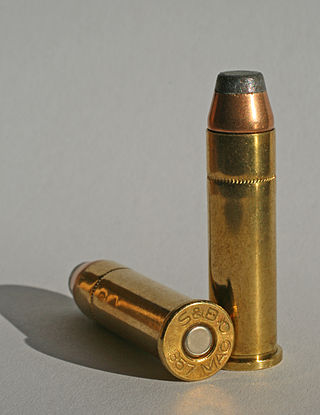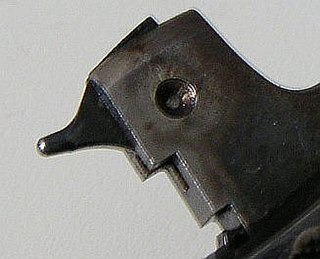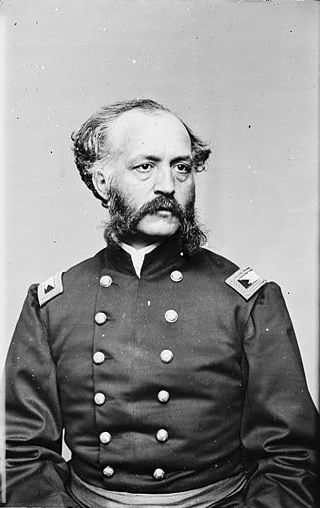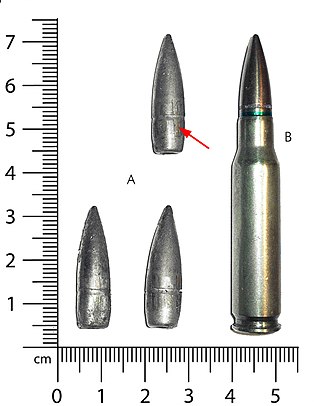Related Research Articles

The percussion cap, percussion primer, or caplock, introduced in the early 1820s, is a type of single-use percussion ignition device for muzzle loader firearm locks enabling them to fire reliably in any weather condition. Its invention gave rise to the caplock mechanism or percussion lock system which used percussion caps struck by the hammer to set off the gunpowder charge in rifles and cap and ball firearms. Any firearm using a caplock mechanism is a percussion gun. Any long gun with a cap-lock mechanism and rifled barrel is a percussion rifle. Cap and ball describes cap-lock firearms discharging a single bore-diameter spherical bullet with each shot.

A cartridge, also known as a round, is a type of pre-assembled firearm ammunition packaging a projectile, a propellant substance and an ignition device (primer) within a metallic, paper, or plastic case that is precisely made to fit within the barrel chamber of a breechloading gun, for convenient transportation and handling during shooting. Although in popular usage the term "bullet" is often used to refer to a complete cartridge, the correct usage only refers to the projectile.

The Congreve rocket was a type of rocket artillery designed by British inventor Sir William Congreve in 1808. The design was based upon the rockets deployed by the Kingdom of Mysore against the East India Company during the Second, Third, and Fourth Anglo-Mysore Wars. Lieutenant general Thomas Desaguliers, colonel commandant of the Royal Artillery at Woolwich, was impressed by reports of their effectiveness, and undertook several unsuccessful experiments to produce his own rocket weapons. Several captured Mysorean rockets were sent to Great Britain following the annexation of the Mysorean kingdom into British India following the death of Tipu Sultan in the siege of Seringapatam.

A center-fire is a type of metallic cartridge used in firearms, where the primer is located at the center of the base of its casing. Unlike rimfire cartridges, the centerfire primer is typically a separate component seated into a recessed cavity in the case head and is replaceable by reloading the cartridge.

A breechloader is a firearm in which the user loads the ammunition from the breech end of the barrel, as opposed to a muzzleloader, in which the user loads the ammunition from the (muzzle) end of the barrel.

Sir William Congreve, 2nd Baronet KCH FRS was a British Army officer, Tory politician, publisher and inventor. A pioneer in the field of rocket artillery, he was renowned for his development and use of Congreve rockets during the Napoleonic Wars.
Primer may refer to:

A firing pin or striker is a part of the firing mechanism of a firearm that impacts the primer in the base of a cartridge and causes it to fire. In firearms terminology, a striker is a particular type of firing pin where a compressed spring acts directly on the firing pin to provide the impact force rather than it being struck by a hammer.

The .303 British or 7.7×56mmR, is a .303-inch (7.7 mm) calibre rimmed tapered bottleneck centerfire rifle cartridge. The .303-inch bore diameter is measured between rifling lands as is the common practice in Europe which follows the traditional black powder convention.

The Battle of Bladensburg, also known as the Bladensburg Races, took place during the Chesapeake Campaign, part of the War of 1812, on 24 August 1814, at Bladensburg, Maryland, 8.6 miles (13.8 km) northeast of Washington, D.C.

A headstamp is the markings on the bottom of a cartridge case designed for a firearm. It usually tells who manufactured the case. If it is a civilian case it often also tells the caliber: if it is military, the year of manufacture is often added.

Hiram Berdan was an American engineer, inventor, military officer, marksman, and guiding force behind and commanding colonel of the United States Volunteer Sharpshooter Regiments during the American Civil War. He was the inventor of the Berdan rifle, the Berdan centerfire primer and other weapons and accessories.

WOLF Performance Ammunition is a trademark associated with Sporting Supplies International (SSI), a corporation founded in the United States in 2005. Most of their ammunition is primarily being manufactured by the Tula Cartridge Plant in Tula, Tula District, Russia, from 2005 to 2009. Some of their 22-caliber rimfire ammunition are also made by Eley Limited in England.
The 1st United States Sharpshooters were an infantry regiment that served in the Union Army during the American Civil War. During battle, the mission of the sharpshooter was to kill enemy targets of importance from long range.

The .303/25, sometimes known as the .25/303 is a wildcat centrefire rifle cartridge, based on the .303 British, necked down to fire a .257 projectile, originating in Australia in the 1940s as a cartridge for sporterised rifles, particularly on the Lee–Enfield action; similar versions also appeared in Canada around the same time.

An artillery fuze or fuse is the type of munition fuze used with artillery munitions, typically projectiles fired by guns, howitzers and mortars. A fuze is a device that initiates an explosive function in a munition, most commonly causing it to detonate or release its contents, when its activation conditions are met. This action typically occurs a preset time after firing, or on physical contact with or detected proximity to the ground, a structure or other target. Fuze, a variant of fuse, is the official NATO spelling.

The 1.59-inch breech-loading Vickers Q.F. gun, Mk II was a British light artillery piece designed during World War I. Originally intended for use in trench warfare, it was instead tested for air-to-air and air-to-ground use by aircraft. Although it fired shells and had no capability to launch rockets, it was widely but misleadingly known as the "Vickers-Crayford rocket gun."

The 7.62×51mm NATO is a rimless, straight walled, bottlenecked, centerfire rifle cartridge. It is a standard for small arms among NATO countries.

In firearms and artillery, the primer is the chemical and/or device responsible for initiating the propellant combustion that will propel the projectiles out of the gun barrel.
The 6.5×53mmR, originally and more correctly produced as the 6.5×53.5mmR, and in imperial system nomenclature known as the .256 Mannlicher, is a late 19th-century rimmed centerfire military rifle cartridge similar to other early smokeless powder designs.
References
- ↑ "Rocket and Rocket Launcher" Archived 2016-03-30 at the Wayback Machine , "Rocket shed brochure"
- ↑ "The Boxer Time Fuse". Royal Canadian Artillery Museum .